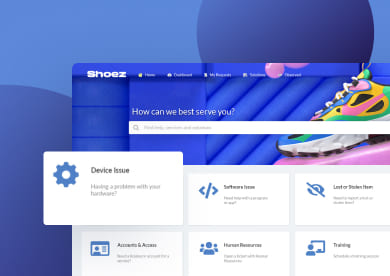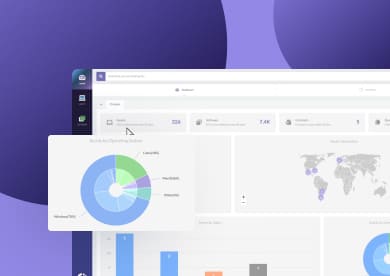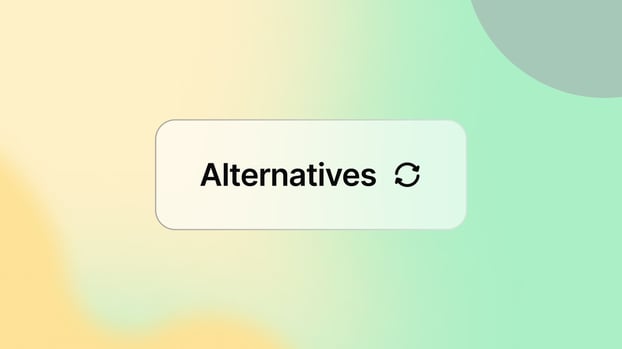There are plenty of Atera alternatives out there and the right one for you will depend on your team’s needs and what you're looking to improve or change.
Some are similar to Atera in their focus on Remote Monitoring and Management (RMM), while others lean more toward IT Asset Management (ITAM) or even full-fledged IT Service Management (ITSM) platforms.
To help you kick off your search, we’ve put together a list of Atera alternatives that offer a variety of capabilities and strengths. If you're considering moving away from Atera, this guide is a solid place to start.
What is Atera?
 Atera is a cloud-based, all-in-one IT Management platform designed for both internal IT departments and Managed Service Providers (MSPs). It combines RMM, PSA, Patch Management, help desk, remote access, and even AI capabilities into a single system.
Atera is a cloud-based, all-in-one IT Management platform designed for both internal IT departments and Managed Service Providers (MSPs). It combines RMM, PSA, Patch Management, help desk, remote access, and even AI capabilities into a single system.
What sets Atera apart is its technician-based pricing model. Unlike most competitors that charge per device, Atera charges per technician — allowing unlimited endpoints under each seat. This model makes it especially attractive to growing teams and MSPs that manage a large number of devices but want predictable costs.
Atera pros and cons
Atera pros
- Unlimited endpoints for a flat price – Its per-technician pricing allows managing as many devices as needed without increasing costs, making it ideal for teams looking to scale.
- All-in-one functionality – Atera bundles RMM, ticketing, patching, reporting, remote access, and more in a single platform, eliminating the need to purchase or integrate multiple tools.
- Fast setup and user-friendly interface – Users consistently highlight its ease of use and quick onboarding. The platform is intuitive even for teams with limited technical resources.
- Strong automation capabilities – Atera allows automation of scripts, patching, and maintenance tasks, enabling IT teams to resolve issues proactively at scale.
- Frequent updates and responsive support – The tool is continuously improved based on user feedback. Atera offers 24/7 customer support, including live chat.
Atera cons
- Limited network discovery accuracy – Some users report that the platform can mislabel or misclassify devices during scans, especially in more complex networks.
- Weaker macOS support – Atera’s features are more robust for Windows environments. Mac support is functional but not as comprehensive, particularly in terms of scripting and agent performance.
- Basic reporting – While reporting is available, it's often seen as lacking in depth and customization compared to more advanced platforms.
- Splashtop dependency for remote access – Remote control is handled via Splashtop, which works well but may not match the preferences or performance of dedicated tools like TeamViewer or ConnectWise Control. Alternatives are possible, but require manual setup.
7 best Atera competitors in 2025
Once again, there are many Atera alternatives. In the following sections, you’ll find a selection of tools that can serve as solid replacements, each with different strengths and focus areas.
- InvGate Asset Management
- ConnectWise Automate
- Kaseya VSA
- Datto RMM
- NinjaOne
- ManageEngine Endpoint Central
- Pulseway
| Tool name | Deployment options | Pricing | Free trial |
| Atera | Cloud | Per technician (unlimited devices) | Yes |
| InvGate Asset Management | Cloud and on-premise | Tiered per-node pricing; starts at ~$0.21/node/month | 30-day full feature trial |
| ConnectWise Automate | Cloud and on-premise | Per endpoint; quote-based | Yes, upon request |
| Kaseya VSA | Cloud and on-premise | Per endpoint; quote-based | Yes, upon request |
| Datto RMM | Cloud | Per endpoint; quote-based | 14-day free trial |
| NinjaOne | Cloud | Per endpoint; quote-based | 14-day free trial |
| ManageEngine Endpoint Central | Cloud and on-premise | Free tier (25 devices); Paid starts at ~$795/year for 50 endpoints | 30-day full feature trial |
| Pulseway | Cloud (on-premise for enterprise) | Per endpoint; quote-based | 14-day free trial |
#1. InvGate Asset Management

There’s no surprise in our first choice: InvGate Asset Management is a dedicated IT Asset Management (ITAM) solution that works seamlessly as an Atera alternative.
While Atera focuses on real-time monitoring and support, InvGate Asset Management excels in helping IT teams gain full visibility and control over their assets.
It automatically discovers, tracks, and manages hardware, software, and cloud resources. Its key differentiator is the platform’s intuitive, no-code interface that makes it easy to use.
InvGate Asset Management features
InvGate Asset Management provides a robust set of capabilities designed to help IT teams control, optimize, and secure their IT environment. Here are its main functionalities:
- Automatic asset discovery and inventory: Automatically identifies and catalogs IT assets across on-premise, virtual, cloud, and even remote environments. Supports both agent-based and agentless discovery to deliver comprehensive visibility over hardware, software, and peripheral devices.
- IT Asset Lifecycle Management & financial tracking: Tracks the full lifecycle of assets—from procurement and deployment to retirement. The system logs key financial details including purchase costs, depreciation, amortization, and warranty data to aid in budget planning and audits.
- Software License Management & compliance: Monitors installed software and matches it against available licenses to ensure compliance with vendor agreements. Flags unlicensed or unauthorized software and helps prepare compliance reports for audits.
- Software metering & optimization: Tracks real-time software usage across devices to identify underutilized licenses. Enables organizations to reduce costs by reclaiming or reallocating unused software assets.
- Remote software deployment: Automates software rollouts and patching tasks across distributed devices. Admins can push targeted installations and updates using asset tags and predefined conditions, reducing manual effort and improving consistency.
- IT Security & compliance enforcement: Monitors critical security indicators like antivirus status, OS patch levels, and firewall activity. Enables proactive risk mitigation by alerting teams when devices fall out of compliance. Supports enforcement of internal policies and regulatory standards.
- Customizable CMDB with relationship mapping: Includes a visual Configuration Management Database (CMDB) that maps dependencies between assets, services, and users. Helps IT teams assess the impact of changes and plan upgrades or incident responses more effectively.
- Change tracking & asset health monitoring: Logs and alerts on hardware, software, or configuration changes. IT teams can define custom asset health rules (e.g., memory usage, outdated OS, or nearing warranty expiration) to detect issues before they escalate.
- Workflow automation & smart tags: Automates key asset management tasks such as assigning software licenses, flagging inactive assets, or triggering ticket creation. Smart tags categorize assets dynamically based on conditions (e.g., "all devices missing AV").
- Contract and Vendor Management: Manages contract details and renewal dates for assets and vendors, helping teams stay ahead of support expirations or license renewals.
- Reporting, analytics & dashboards: Offers customizable dashboards and reports to monitor asset health, software compliance, usage trends, financial metrics, and lifecycle status. Reports are no-code configurable and exportable for auditing or stakeholder communication.
- Native integration with InvGate Service Management: Seamlessly connects to InvGate’s ITSM solution to provide ticket context, link incidents to assets, automate changes, and enhance service delivery efficiency.
InvGate Asset Management pros
- Offers full asset visibility across physical, virtual, and cloud environments
- Custom fields and dashboards can be configured easily with no-code tools
- Available as both SaaS and on-premise deployment
- Integrates with ITSM platforms and third-party tools via API
- Highly rated customer support and development responsiveness
InvGate Asset Management cons
- Advanced features like CMDB relationship mapping may require a learning curve
- Customization for very niche use cases may be limited
- Built-in reporting may not meet the needs of very large enterprises
- Does not include live monitoring or remote support—only ITAM functions
InvGate Asset Management comments and reviews
InvGate Asset Management holds a 4.7/5 rating on Gartner Peer Insights and a 4.7/5 on G2. Users frequently praise its ease of use, support, and fast implementation.
"We have had an overall very positive experience with InvGate. We implemented both Asset Management and Service Management a little over two years ago. The product is simple to setup and integrate with. Their support has been responsive, and the account managers are very attentive to our specific use cases and needs."
Gartner Peer Insights reviews
InvGate Asset Management pricing
InvGate Asset Management offers a tiered pricing model based on the number of nodes.
- Starter Plan: ~$0.21 per node/month (up to 500 nodes, billed annually)
- Pro Plan: ~$0.38 per node/month (501–10,000 nodes, billed annually)
- Enterprise Plan: Custom pricing for large-scale or advanced needs
It includes a 30-day free trial with full access to features. No free-forever tier is available, but support is included in all plans. Deployment can be cloud-based or on-premise, depending on organizational needs.
#2: ConnectWise Automate
 ConnectWise Automate is a dedicated RMM platform known for its deep automation capabilities and technical flexibility.
ConnectWise Automate is a dedicated RMM platform known for its deep automation capabilities and technical flexibility.
While Atera provides a more unified, user-friendly experience, ConnectWise leans into scalability and granular control. It’s a solid choice for large MSPs or IT teams that require advanced scripting, customized workflows, and optional outsourced NOC/help desk services.
ConnectWise Automate features
- Advanced RMM capabilities with customizable agent monitoring and alerts
- Built-in scripting engine with extensive script library
- Granular patch management for Windows and third-party software
- Remote access integration via ConnectWise Control
- Integration with ConnectWise NOC/help desk services (optional)
- Asset inventory and basic documentation tracking
ConnectWise Automate pros
- Offers deep automation and scripting tools to reduce manual workload
- Includes strong patch management features for security and compliance
- Optional NOC and help desk services extend internal IT teams
- Highly scalable and customizable for large MSPs or complex environments
- Integrates with the full ConnectWise platform and major IT tools
ConnectWise Automate cons
- Steep learning curve and complex initial setup process
- Outdated and cluttered user interface hampers ease of use
- Requires multiple modules (PSA, remote, etc.) for full functionality
- Support response times can be inconsistent
- Higher cost and no transparent pricing may limit accessibility for smaller teams
ConnectWise Automate comments and reviews
ConnectWise Automate has a 4.2/5 rating on Capterra and a 4.1/5 rating on G2, primarily listed under RMM and remote support categories. Reviews often praise its robust features and automation but caution about its complexity.
"ConnectWise is a great example of an easy-to-navigate app and will not require any difficult instructions to learn."
Gartner Peer Insights
ConnectWise Automate pricing
ConnectWise Automate uses a per-endpoint pricing model, with volume discounts available for larger environments. Exact pricing is not publicly listed and usually requires contacting ConnectWise for a custom quote.
There is no free tier, but free trials and demos are available by request. Keep in mind that full functionality may require bundling with other ConnectWise tools (like Manage or Control), each with separate costs.
#3: Kaseya VSA
 Kaseya VSA (Virtual System Administrator) is the flagship RMM solution from Kaseya, part of its broader IT Complete suite that includes PSA, backup, and cybersecurity tools. It’s designed to centralize IT operations for MSPs and internal IT teams, offering remote monitoring, automation, patching, and more.
Kaseya VSA (Virtual System Administrator) is the flagship RMM solution from Kaseya, part of its broader IT Complete suite that includes PSA, backup, and cybersecurity tools. It’s designed to centralize IT operations for MSPs and internal IT teams, offering remote monitoring, automation, patching, and more.
Kaseya VSA stands out for its powerful scripting engine and broad feature coverage. Compared to Atera, it offers deeper automation capabilities and tighter integrations with other Kaseya products like IT Glue and Datto.
Kaseya VSA features
- Remote Monitoring and Management — Track performance, uptime, and health across endpoints.
- Automated Patch Management — Automate OS and software updates with policy-driven rules.
- Remote access and control — Secure remote desktop capabilities for fast troubleshooting.
- Custom scripting engine — Automate virtually any endpoint task with built-in or custom scripts.
- Policy-based configuration — Define and enforce IT policies across user or device groups.
- Asset Lifecycle Management — Inventory, track, and manage hardware/software assets over time.
Kaseya VSA pros
- VSA can be deployed on-premises or in the cloud.
- Offers a comprehensive suite of RMM features in one unified platform.
- Automation and scripting reduce manual workloads significantly.
- Scales reliably for large environments with thousands of endpoints.
- Deep integrations with IT Glue, Datto, BMS, and other Kaseya-owned tools.
- Multi-tenant support and MSP-focused reporting are built-in.
- Cost-effective bundles available when adopting the Kaseya ecosystem.
Kaseya VSA cons
- Interface is complex and has a steep learning curve.
- Support response times can be slow or inconsistent.
- No instant free trial; access is gated behind a sales process.
- Per-endpoint pricing can be expensive at scale compared to Atera’s per-technician model.
- Historical security concerns due to a 2021 ransomware incident.
- Initial setup and configuration can be time-consuming and require training.
Kaseya VSA comments and reviews
- Gartner Peer Insights: 4.5 out of 5 stars
- G2 rating: 4.1 out of 5 stars
"Kaseya VSA provides a very powerful set of tools to manage endpoints across multiple clients. It works well. Customer service is a bit disappointing at times."
Gartner Peer Insights
Kaseya VSA pricing
Kaseya VSA uses a per-endpoint pricing model, with quotes tailored to your device count and bundled tools. Pricing is not publicly listed, and usually requires negotiation with a sales representative.
- Free trial: Available upon request (not instant sign-up).
- Free version: Not available.
- Demo: Available upon request.
- Bundles: Often offered with IT Glue, Datto, and other Kaseya tools for discounted rates.
#4: Datto RMM
 Datto RMM is a cloud-native RMM solution originally developed by Datto and now part of the Kaseya portfolio. It’s a secure, SaaS-based platform used by MSPs and IT departments to manage endpoints, automate tasks, and monitor system health at scale.
Datto RMM is a cloud-native RMM solution originally developed by Datto and now part of the Kaseya portfolio. It’s a secure, SaaS-based platform used by MSPs and IT departments to manage endpoints, automate tasks, and monitor system health at scale.
Its key differentiator is its “security-first” approach, featuring native ransomware detection, enforced two-factor authentication, and robust patch automation. Compared to Atera, Datto RMM brings a stronger focus on endpoint security and seamless integrations with the broader Datto/Kaseya ecosystem—making it a compelling option for MSPs that prioritize security, scalability, and centralized visibility.
Datto RMM features
- Cloud-based remote monitoring — Monitor device status, system health, and performance from a central cloud dashboard.
- Automated Patch Management — Schedule and deploy OS and third-party patches with policy-based controls.
- Built-in ransomware detection — Identify and alert on behaviors that suggest ransomware activity.
- Custom automation scripting — Automate tasks using job scheduling and reusable scripts.
- Remote access (Splashtop & VNC) — Securely connect to devices for real-time troubleshooting.
- PSA and backup integrations — Seamless data sync with Autotask PSA and Datto BCDR appliances.
Datto RMM pros
- Prioritizes security with built-in ransomware detection and mandatory 2FA.
- Cloud-native platform with no infrastructure to manage.
- Easy-to-use modern UI with a short learning curve.
- Strong patch management and customizable automation.
- Integrates well with the broader Datto and Kaseya ecosystems.
- Mobile-friendly dashboard and responsive support team.
Datto RMM cons
- Remote control experience isn’t as smooth as some dedicated remote access tools.
- Occasional UI performance bugs, especially with large data sets.
- No on-premise deployment option for air-gapped environments.
- Pricing is not publicly available and requires a quote.
- Minimum agent commitments may apply for new customers.
- Limited built-in ticketing (PSA functionality handled separately via Autotask).
Datto RMM comments and reviews
- Gartner Peer Insights: 4.2/5.
- G2 rating: 4.7 out of 5 stars
"Datto RMM is a good product for managing and monitoring devices, it does not have many capabilities as other RMM tools, but it covers the basics."
Gartner Peer Insights
Datto RMM pricing
Datto RMM follows a per-device pricing model with quote-based rates. Pricing is not publicly listed and typically depends on the number of endpoints managed and additional tools bundled (like Autotask PSA or Datto BCDR).
- Free trial: Yes – 14-day free trial available via Datto.
- Free version: Not available.
- Demo: Personalized demo available upon request.
- Bundles: Often included in broader MSP packages under Kaseya's IT Complete offerings.
#5: NinjaOne
 NinjaOne (formerly NinjaRMM) is a cloud-native IT Management platform built to simplify endpoint monitoring, patching, and remote support. While it began as an RMM tool, NinjaOne has evolved into an all-in-one solution that includes backup, scripting, software deployment, and even basic ticketing.
NinjaOne (formerly NinjaRMM) is a cloud-native IT Management platform built to simplify endpoint monitoring, patching, and remote support. While it began as an RMM tool, NinjaOne has evolved into an all-in-one solution that includes backup, scripting, software deployment, and even basic ticketing.
What sets NinjaOne apart from Atera and other tools is its unmatched ease of use, fast deployment, and top-rated customer support. It’s especially favored by MSPs and small-to-mid-sized IT teams who want to get started quickly and manage endpoints efficiently without a steep learning curve.
NinjaOne features
- Remote monitoring and alerting — Track endpoint performance and receive real-time alerts.
- Automated Patch Management — Apply OS and third-party updates on schedule.
- Built-in remote access — Connect via TeamViewer or Splashtop for fast support.
- Custom scripting engine — Deploy PowerShell and other scripts at scale.
- Integrated ticketing — Lightweight ticketing to track issues internally or for clients.
- Software deployment and inventory — Push applications and track installed software across endpoints.
NinjaOne pros
- Extremely intuitive interface and fast learning curve.
- Consolidated dashboard for RMM, ticketing, patching, and remote access.
- Consistently praised support team with rapid response times.
- Quick to deploy and scalable for growing MSPs or IT teams.
- Regular feature updates driven by user feedback.
- Mobile app for on-the-go device management and alerts.
NinjaOne cons
- It’s delivered entirely as a SaaS with no on-premise option
- Limited ITSM depth compared to full-service platforms like ServiceNow or ManageEngine.
- Per-device pricing may be expensive for large device fleets.
- No on-premise deployment option for air-gapped environments.
- Some advanced modules (like backup or MDM) still maturing.
- Minimal native network device monitoring.
- Lacks native CMDB or change management for enterprise ITSM use cases.
NinjaOne comments and reviews
- Gartner Peer Insights rating: 4.8 out of 5 stars
- G2 rating: 4.7 out of 5 stars
Ninja is the best RMM we have ever used, it's fast, very customizable, and the UI is easy to understand and modern. It has made managing systems mostly effortless and much more efficient than our previous system.
Gartner Peer Insights
NinjaOne pricing
NinjaOne uses a per-device pricing model, typically with different rates for servers and workstations. Exact pricing is quote-based and not publicly listed.
- Free trial: Available (usually 14 days, on request).
- Free version: Not available.
- Demo: Yes, personalized demo offered upon request.
- Billing model: Monthly or annual, with volume discounts.
#6: ManageEngine Endpoint Central
 ManageEngine Endpoint Central (formerly Desktop Central) is a Unified Endpoint Management (UEM) solution. It’s available both on-premises and in the cloud, and it's part of a broader suite of IT tools that include add-ons for endpoint security, analytics, and IT service management.
ManageEngine Endpoint Central (formerly Desktop Central) is a Unified Endpoint Management (UEM) solution. It’s available both on-premises and in the cloud, and it's part of a broader suite of IT tools that include add-ons for endpoint security, analytics, and IT service management.
Known for its comprehensive feature set, Endpoint Central blends IT Asset Management, Remote Monitoring, and even Mobile Device Management.
Compared to Atera, it offers more granular control over configurations, OS deployment, and security policies. It’s a go-to for IT teams needing an all-in-one Endpoint Management platform with both flexibility and depth.
ManageEngine Endpoint Central features
- Automated Patch Management — Scan, approve, and deploy OS and third-party patches across devices.
- Remote desktop and troubleshooting tools — Securely control and resolve endpoint issues.
- Software deployment and license tracking — Distribute applications and manage license compliance.
- IT asset Inventory and Lifecycle Management — Track hardware and software across their lifespan.
- OS imaging and deployment — Capture, customize, and deploy system images to new machines.
- Mobile Device Management (MDM) — Manage Android and iOS devices alongside desktops and laptops.
ManageEngine Endpoint Central pros
- Extremely comprehensive toolkit covering ITAM, RMM, and endpoint security.
- Available both on-premises and as a cloud service, with offline LAN options.
- Offers free version (up to 25 devices) and affordable perpetual licensing.
- MSP edition allows multi-tenant management from a single console.
- Strong patch automation for OS and third-party software.
- Integrates smoothly with other ManageEngine tools for ITSM and analytics.
ManageEngine Endpoint Central cons
- Interface can feel outdated or overwhelming, especially on-premise.
- Steeper learning curve due to the wide array of features.
- Support may be slower on basic or free tiers.
- Advanced analytics or service desk features require other ManageEngine products.
- Setup and initial policy configuration can be time-consuming.
- Some modules (e.g., endpoint security) are paid add-ons.
ManageEngine Endpoint Central comments and reviews
- Gartner Peer Insights rating: 4.6 out of 5 stars (1,500+ reviews)
- G2 rating: 4.4 out of 5 stars
"ENDPC is a very good product. It is a great one-stop-shop for managing many different devices and operating systems, from a basic level to a high-end level."
Gartner Peer Insights
ManageEngine Endpoint Central pricing
ManageEngine offers multiple editions with both subscription and perpetual license options:
- Free edition: Manages up to 25 endpoints (including mobile devices), ideal for small teams.
- Professional edition: Starts at ~$795/year for 50 endpoints (on-premise); cloud version starts at ~$104/month.
- Enterprise edition: Adds advanced features like software metering; starts at ~$945/year (on-prem) or ~$124/month (cloud) for 50 devices.
- UEM and Security add-ons: Available separately or bundled in higher-tier editions.
- MSP edition: Subscription-based, with pricing based on managed endpoint volume.
There is a 30-day free trial for all editions, with access to all features. ManageEngine Endpoint Central stands out for its pricing flexibility, with options for long-term savings through perpetual licensing or accessible entry via its generous free tier.
#7: Pulseway
 Pulseway is a cloud-first RMM platform, with an on-premises option available for enterprise customers. It’s best known for its mobile-first design, enabling IT professionals to manage their entire infrastructure directly from their smartphone.
Pulseway is a cloud-first RMM platform, with an on-premises option available for enterprise customers. It’s best known for its mobile-first design, enabling IT professionals to manage their entire infrastructure directly from their smartphone.
What sets Pulseway apart from Atera is its lightweight setup, real-time alerting, and powerful mobile app that allows admins to respond to issues on the go. It’s particularly well-suited for smaller IT teams, MSPs, or solo admins looking for agility without the complexity of full-stack ITSM or ITAM platforms.
Pulseway features
- Mobile-first RMM platform — Monitor and manage systems from a powerful mobile app.
- Real-time system alerts — Get push notifications for performance issues or service outages.
- Patch Management and automation — Deploy OS and third-party updates and run scripts remotely.
- Remote desktop and control — Access and manage endpoints directly from the console or mobile.
- Integrated PSA and antivirus add-on — Basic ticketing system and optional security tools.
- Multi-tenant dashboard for MSPs — View and manage client endpoints from a single portal.
Pulseway pros
- Mobile app allows admins to receive alerts and take actions instantly from anywhere.
- Easy to set up and use, with low learning curve and fast deployment.
- Built-in PSA, antivirus, and automation tools reduce need for extra platforms.
- Responsive and helpful customer support team with fast feature rollouts.
- Free plan available for up to 2 personal devices.
- Monthly pricing available with no long-term contract required.
Pulseway cons
- Remote desktop lacks robust features like full multi-monitor support.
- PSA and ITSM capabilities are basic compared to enterprise-grade solutions.
- Some automation and patching options are less advanced than in larger RMMs.
- Onboarding fee ($149) can be a barrier for small businesses or MSPs.
- Not ideal for very large-scale environments or complex integrations.
- Per-device pricing may become expensive at high volumes.
Pulseway comments and reviews
- Capterra rating: 4.7 out of 5 stars
- G2 rating: 4.6 out of 5 stars
"Pulseway has become an integral and indispensable part of our company's infrastructure. Pulseway provides rock solid solutions that are well supported and continuously improved upon. We are very satisfied with the services and support we receive."
Capterra reviews
Pulseway pricing
Pulseway follows a per-endpoint pricing model with tiered discounts, meaning costs decrease as the number of devices increases. You can customize your plan by selecting core features and optional security add-ons.
-
Offers a 14-day free trial that includes RMM, PSA, patching, and network monitoring.
-
Supports monthly, annual, and 3-year payment options, with discounts for longer commitments.
-
A one-time onboarding fee applies for Advanced Onboarding and Best Practices training.
Pricing varies depending on your selections, and a quote can be generated directly on Pulseway’s website.















